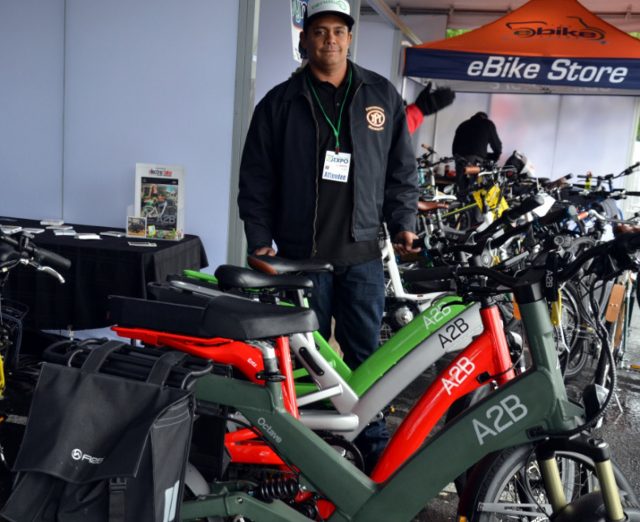
(Photos: M.Andersen/BikePortland)
As Jonathan wrote on Friday, this weekend’s Electric Bike Expo has been a milestone for Portland, a metro area that offers a rich bike-friendly culture but also has enough hills that many people are effectively shut out of it.
Enter e-bikes. And enter the expo, a free event outside the Lloyd Center movie theater that brought in vendors from around the country. As an e-bike newbie — I’ve written about them plenty but only ridden one before — I spent a few hours there on Saturday to see some of the products and talk to the customers and sellers. Here’s a quick tour of what I found.
Trek’s urban e-bikes
The first seller I spoke with Saturday was David Studner, Wisconsin-based product manager for city bikes at Trek. It’s great to see pedal-assist e-bikes being treated as just one more segment of that product category. Their new Trek Conduit+, which goes for $2,999, comes with built-in automatic front and rear lights:
and a rear cargo rack:
They’re also offering the Lift+, which sells for $2,799 and offers an extremely upright seating.
“I don’t care if you have a carbon fiber $7,000 bike — you cannot average 25 mph.”
— David Studner, Trek
“It delivers on a promise that this is what a bike should feel like to someone who hasn’t ridden a bike in a long time,” Studner said.
Or for a bit more cash you can get the XM700+, which has a 28 mph top speed, enough to more or less keep up with car traffic on many city streets.
“I don’t care if you have a carbon fiber $7,000 bike — you cannot average 25 mph,” Studner said. The XM700+ retails for $3,499.
Studner doesn’t personally specialize in mountain bikes, but we took a moment to talk about the state of e-bikes in mountain biking. He made the interesting argument that bikes should eventually be regulated not based on their equipment but on the behavior of their users.
“Every car in America is capable of breaking every posted speed limit,” Studner said. “With the current state of mountain biking, there’s nothing to say an aggressive biker can’t bomb down a certain trail.”
KTM: Mountain biking specialists, thinking ahead
Fans of mountain e-bikes say they have huge promise both for mountain biking (apparently they make the climb slightly easier) and for e-bike retailers. But there’s that nagging fact that many states and the federal government restrict their use on off-road trails.
“People are like an e-bike weighs more. I’m like, no, what if you had a rider that was 20 pounds heavier? You could say the same thing for a fat bike. Fat bikes wear the same as an e-bike.”
— Freddy Viera, KTM
Freddy Viera of KTM respectfully disagreed with Studner, saying he thinks the country is moving toward allowing Type 1 mountain bikes — no throttle but a pedal assist of up to 20 mph — on almost all mountain biking trails.
“Having a speed limit and a governor that can’t be turned off is a good idea,” he said. “If you don’t have some sort of limit, the liability for the parks is going to be higher.”
Viera, who lives in Miami, described himself ruefully as “the No. 1 hated guy right now on the mountain bike trail, because I’m an advocate” for e-bikes, he said.
“The wear and tear on the trail is dependent on the rider,” Viera explained. “People are like an e-bike weighs more. I’m like, no, what if you had a rider that was 20 pounds heavier? You could say the same thing for a fat bike. Fat bikes wear the same as an e-bike.”
Ultimately, Viera said, every vehicle is only as sensible as the person using it.
“If you’re driving your car going too fast in the rain down a mountain, at some point you’re going to be like, oh fuck, I’m going too fast,” Viera said.
KTM offers three Type 1 mountain bikes, all with mid-drives (at the pedals) to improve their handling, ranging from $4,295 to $5,370.
As I wrapped up with Viera, Jonathan Crutcher (right in the photo above) got back from a test ride of KTM’s hardtail.
“It’d be nice if it went a little bit faster,” Crutcher said. “Other than that, it was awesome.”
Price buster: A $1200 e-bike
At the booth of southeast Portland shop Cynergy E-bikes, I saw the EG Athens 250, which retails for a startling $1,199.
“It’s pretty uncharted territory,” Cynergy’s Tyler Desjardines said. “At least for an e-bike that isn’t…” He trailed off.
“Shit?” I offered.
“You can say it, I can’t,” he said. “You talk about failure percentages, this is the best bike. They go out the door and they never come back.”
I asked Desjardins what the price secret was. Basically, he said, it’s the entry-level components, including rim brakes. (Desjardins mentioned that if he had his druthers, EG creator Wayne Hui would also make a version with hydraulic disc brakes.)
Desjardines said the 54-pound Athens 250 doesn’t make major sacrifices on its battery, which puts out 250 watts and offers 40 miles per charge.
Sleek beauty: The Faraday Porteur
Cynergy was also showing off an e-bike that doesn’t look like an e-bike: the Faraday. With its batteries slipped up the downtube (they’re accessible through the bottom bracket) and basic controls beneath the seat, Faraday looks and feels simple. Its carbon belt drive keeps the service costs down.
“I call it the iPhone of e-bikes,” Desjardines said.
The Porteur retails for $3,500; the cheaper S version uses a chain drive and costs $2,499. For this weekend, Cynergy had it outfitted with a bamboo-trimmed front rack ($225) and a leather U-lock holster ($85).
Local pioneer: The eBike Store innovates on service
Portland now has a jaw-dropping seven e-bike specialty stores. At least, that’s the count from the guy who started the first one.
“About a third of our customers are getting out of their car.”
— Wake Gregg, eBike Store
Wake Gregg, who founded north Portland’s eBike Store after a 2008 trip to China, said competition has brought pluses and minuses but on balance it’s forced him to keep coming up with new ideas. His latest is a new roadside assistance program and rapid-service guarantee.
“About a third of our customers are getting out of their car,” Gregg said. When an e-bike is your primary vehicle, Gregg said, you need to be ready when something goes wrong with it. So, to accompany this weekend’s show, Gregg rolled out what he said is Portland’s first service maintenance plan for e-bikes. For $195 per year, he’ll be offering:
• 24/7 roadside assistance from the Better World Club, including up to two rides of up to 30 miles
• up to 10 flat repairs per year
• unlimited immediate brake, shifting or seat adjustments
• a free tune-up
For another $90 per year you can upgrade that tune-up to an overhaul, plus a 10 percent discount and a free loaner bike for scheduled services and emergencies.
Among other one-less-minivan type products, Gregg showed off the Juiced Rider (pictured above), a longtail with a throttle and 330 ounds of cargo capacity (not counting the rider) that gets 60 miles of median range assuming three hours at 20 mph. It retails for $2,000.
Advertisement
A2B’s motorcycle-inspired lineup
A2B is a distinctive brand that originated in the United Kingdom but has also put down stateside roots.
“It was one of the first purpose-built e-bikes in the U.S.,” said Keola Munos, the western U.S. sales manager.
“These actually took a close resemblance to World War II motorcycles,” Munos said. “That’s how a lot of my customers relate to it — it’s just a little motorcycle.”
Though as long as the top stays below 28 mph, Munos noted, they don’t require a driver’s license.
The oldest, sturdiest A2B model is the Octave, named for an aviation pioneer who worked with the Wright Brothers. It weighs 90 pounds and offers dual battery capacity (it comes with one). Each battery has a 15-20 mile range and retails for $3,500 to $3,800. Their newest version, not yet widely available, is the $5,000 Entz, which offers an option between automatic or manual shifting.
But the A2B’s leading model in the U.S. is its folding Kuo electric bike, which goes for $1,700 and offers an 18-20 mile range at up to 18 mph speeds. Munos said it’s about 60 percent of his business, thanks to popularity among people who combine it with RVs, airplanes and boating.
Opening politicians’ eyes
There wasn’t enough time to get to every vendor, sadly. But as I was wrapping up my round and getting ready for a few test rides of my own, Rich Fein, the owner of Cynergy E-Bikes and a co-organizer of the expo, flagged me down.
Fein wanted to make sure we didn’t neglect another benefit of the show: a visit that Milwaukie Mayor Mark Gamba had arranged so various regional elected officials could try using e-bikes — and realize that as they spread, they have the potential to open biking as a regular transportation option for many more people.
“I took them on a ride up Alameda Ridge,” Fein said. “They got really giddy. They really got it. … Nobody understands these bikes until they’re on them.”
Fun on the test-ride track
I expect to be in the market for a longtail e-bike in a few years myself, so before things wrapped up Saturday, I wanted to try getting some time in a few saddles — but first I got a few shots of other folks shopping or enjoying themselves on the temporary circular track that had been set up in the Lloyd Center movie theater’s parking lot.
Among the great things about this event was that it was attracting people I don’t see at many of the bike events I attend: more women, more older folks, speakers of more languages (I think I overheard four) and more variety in people’s colors and cultures. I don’t know what the reason might be. But organized bike advocacy can sometimes feel like a small tent. If e-bikes can help us build a bigger one over the years to come, that’ll be exciting.
CORRECTION: This story was originally published with the price of the Faraday Porteur S as $2,700. The price is $2,499. Sorry for any confusion.
— Michael Andersen, (503) 333-7824 – michael@bikeportland.org
Our work is supported by subscribers. Please become one today.



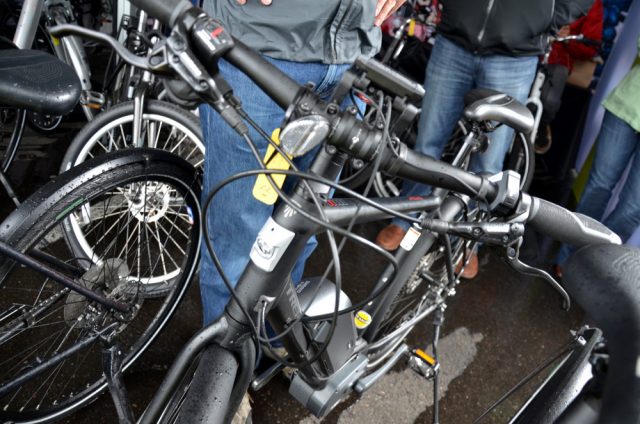
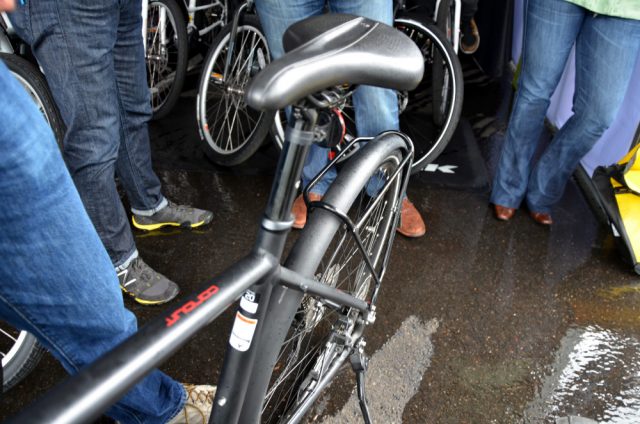
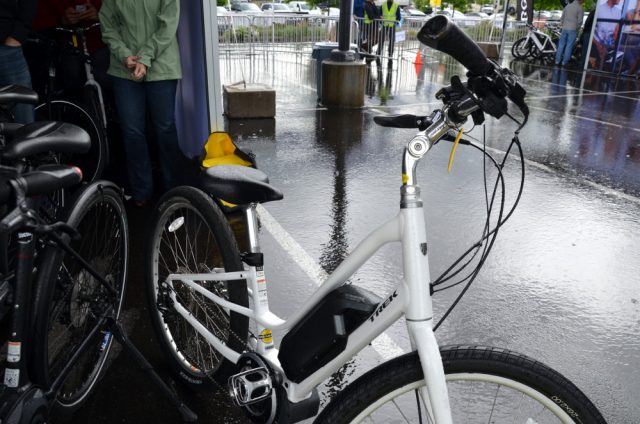
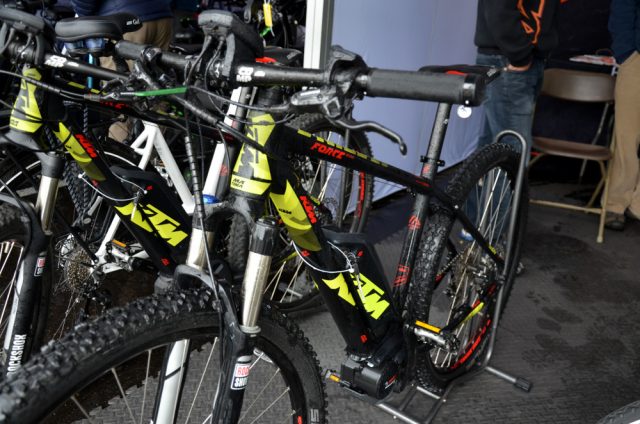
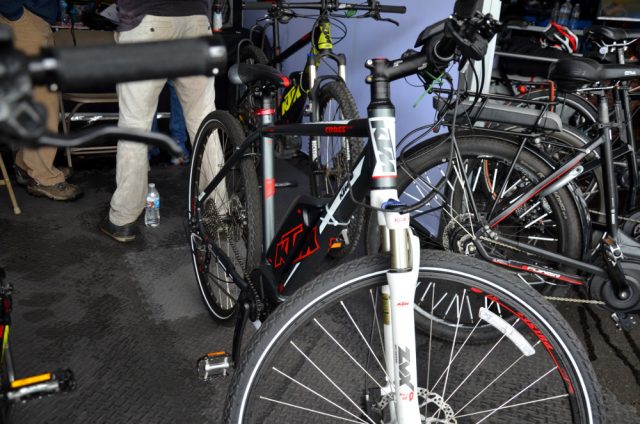
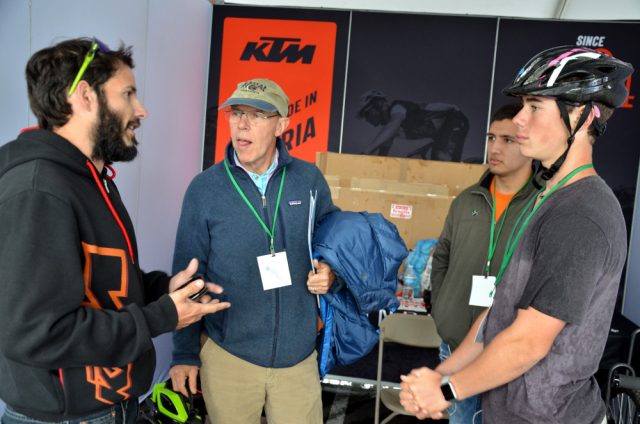
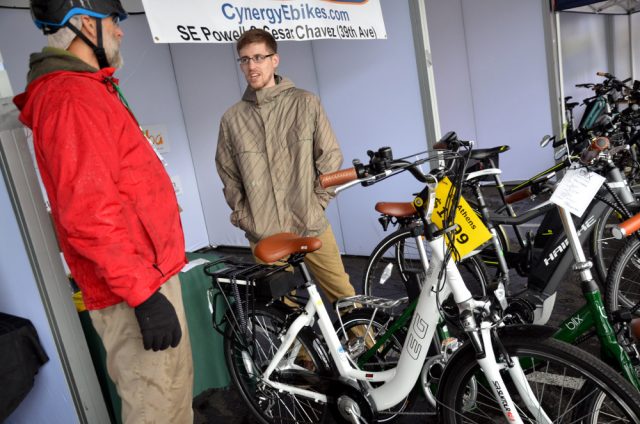
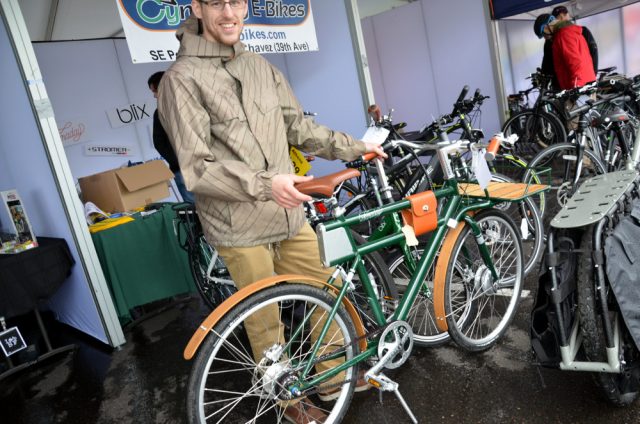
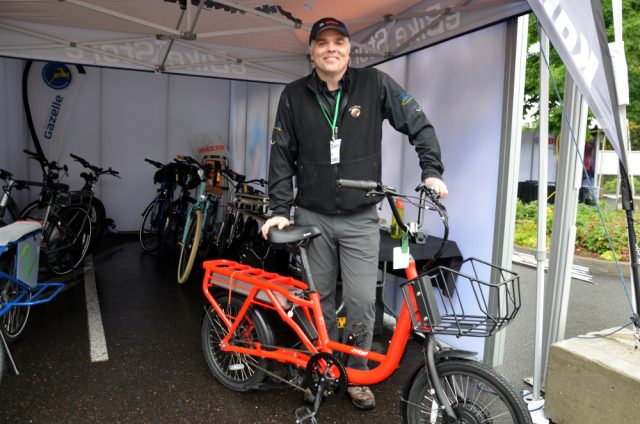
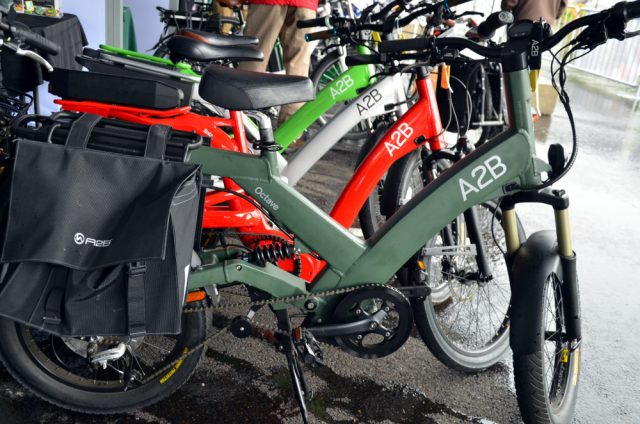
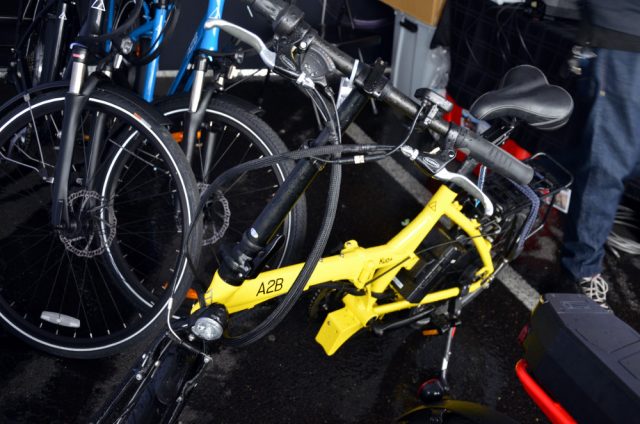
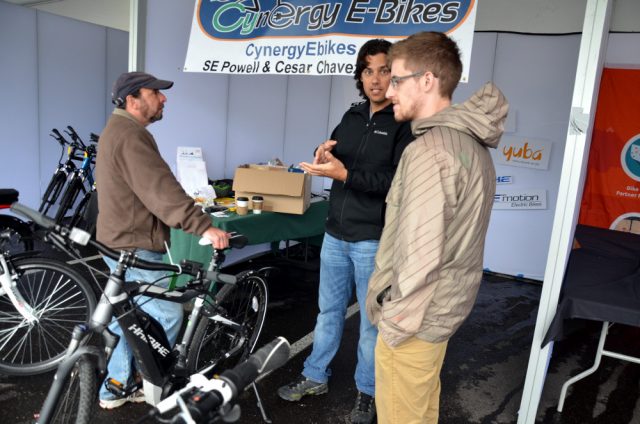
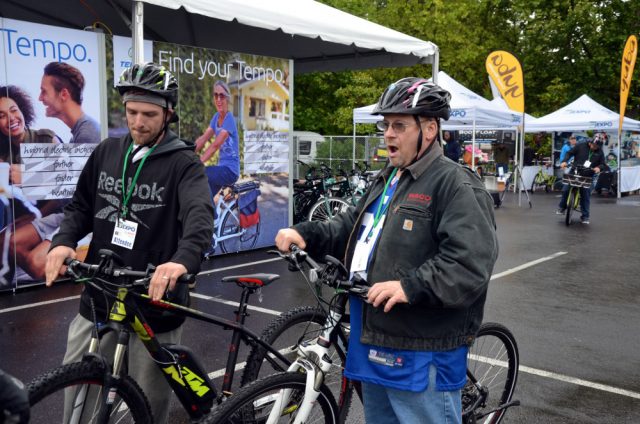

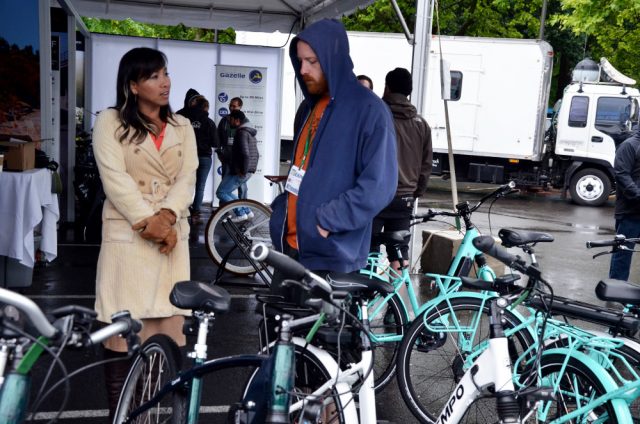
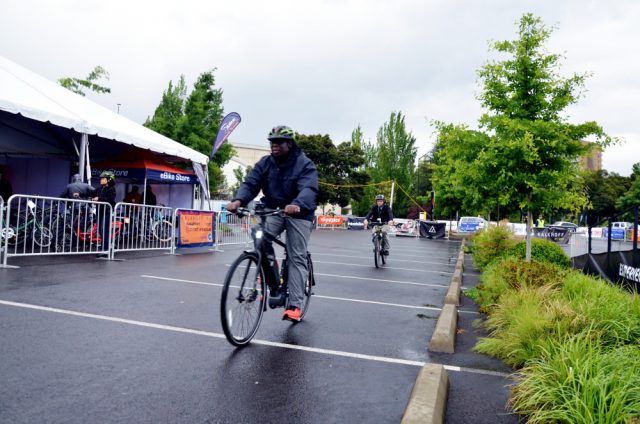
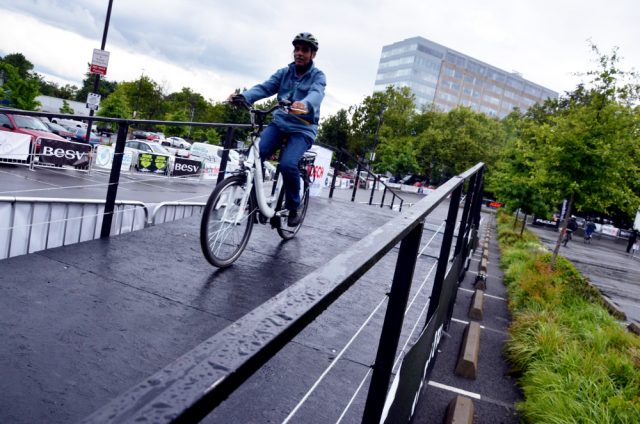
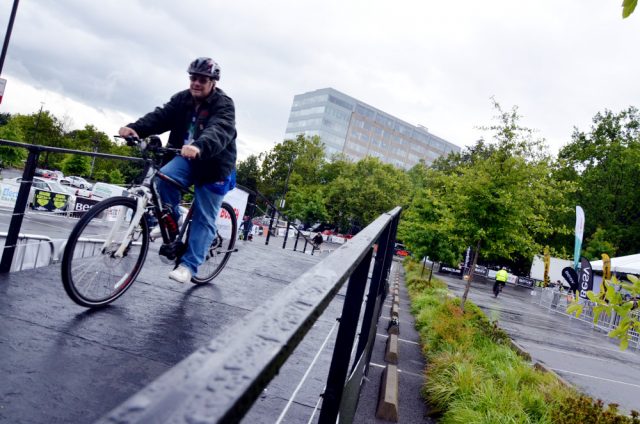
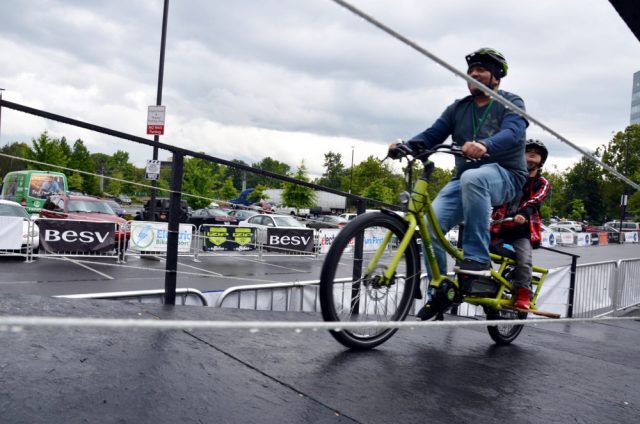
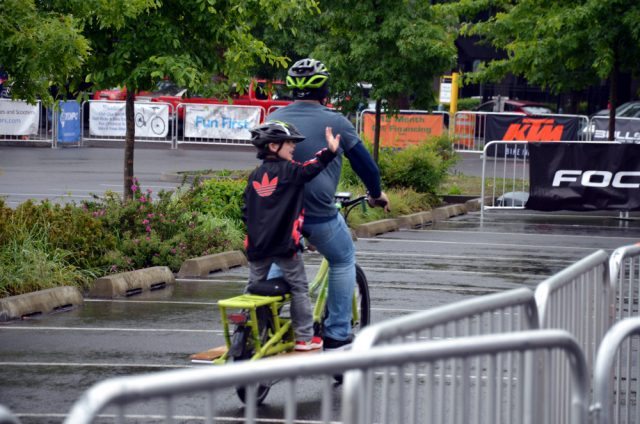

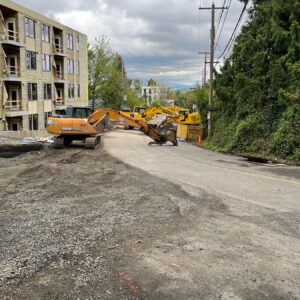

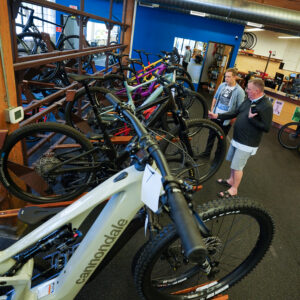
Thanks for reading.
BikePortland has served this community with independent community journalism since 2005. We rely on subscriptions from readers like you to survive. Your financial support is vital in keeping this valuable resource alive and well.
Please subscribe today to strengthen and expand our work.
I have no “moral” problem with e-bikes, (and I think they can be very fun to ride) but I can’t help but feel uneasy when I see someone cruising in a bike lane at high speed on what seems to be a low-powered electric motorcycle in the form of a bike. On the other hand, we’ve always had speed differentials between cyclists. Nonetheless, e-bikes may become more of an issue as they gain popularity.
I’ve been passed very close and at high speeds with no warning on many occasions. Although the racers who use bike lanes for training are just as dangerous as the e-bikes. And they are more inconsiderate.
I’ve been riding street & mtn. bikes since 1984. And by far the “scariest” riders are the street riders going at 25+ mph on their bikes. I’ve been passed SILENTLY too many times to count and it has startled me at times. It’s the rider not the bike that can be the problem…just as in everything else when a human being is dealing with an inanimate object.
I wonder how effective a helmet will be at those higher speeds.
I’m sold, the only thing holding me back is the price. I did attend this weekend and rode lots of different bikes, I even have a favorite picked out. As I am getting older, the grind going up the Glenn Jackson bridge into Vancouver after a long day at work is really becoming a drag. This “drag” can be significantly reduced with an ebike and I would still have my other bikes for recreational riding. Who knows, maybe I would even get rid of my car, wouldn’t that be great
If you are holding back because you want a turnkey ready ebike, I can understand your hesitancy, because the bikes at the Expo were sweet! But, there is always the option of fitting a kit onto one of your existing rides that will work well, albeit without the look of the purpose built ebike. Look around and about, there are many to choose from. All of which would have a nice outcome at a reduced price. Several of the local ebike shops have conversion kits to choose from, just ask!
USFS has, at times, used “motorized’ and “mechanized” interchangeably when referring to mt. bike access; typically when trying to justify denying said access. I would imagine e-Mt Bikes will further muddy that water.
This is nice and clear;
NO
MOTORIZED
VEHICLES
Interestingly, motorcycles don’t have a motor; they have an engine. In other words, motorized vehicles aren’t.
— Hello, Pedantic Kitty
“enginecycle” doesn’t really roll of the tongue though does it? Of course, neither does “electric-assist mountain bike”.
Of course electric-assist bikes have electric motors, so does that make them E-motorbikes?
Yikes! On the comments about mountain biking. On road, it makes sense to allow e-bikes on bike oriented facilities because they mostly operate at a fundamentally much lower speed than motorized vehicles. So it makes sense NOT to consider them motorcycles.
On trails, though? The distinction between an e-bike and a motorcycle is much less clear. I doubt we are moving towards a situation where e-bikes are allowed on all MTB trails; more likely (and hopefully), we will find them banned on all MTB trails.
“Fat bikes wear the same as an e-bike.” Bullcrap. Weight is not the only issue (erosion or otherwise) that e-bikes raise on trails.
And another thing: we’ve had a difficult enough time getting access to trails for mountain biking when the bikes were human powered. If MTB access means allowing e-bikes too, we’re going to encounter a lot more resistance and get kicked off a lot more trails. Thanks a lot, a-hole.
On some fundamental level, it is difficult to distinguish an e-bike from a motorbike. There are, of course, superficial differences in energy source, noise, emissions, power, etc., but these are different points along a continuum, unlike, say the difference between human powered and machine-assisted, which can be drawn more clearly.
Dirt bikes are very loud and spit out toxic emissions. I don’t consider the differences to be superficial. The impact goes beyond the trail. You have to consider the other users in the area. I don’t know anyone that would choose to backpack on a trail shared with dirt bikes or quads.
Or high speed electric bicycles. You are right that superficial may not have been the right word, but the point was that these things exist on a continuum, and someone is going to have to draw a line somewhere.
IMDB recently conducted a soil displacement test regarding eBikes. I had the opportunity to attend when they presented the result. Essentially, throttle-based electric bicycles general displace soil at a rate that is equivalent to a gas powered dirt motor bike, whereas pedal assisted electric bicycles soil displacement is equivalent to that of a mountain bike.
Here is a link to an article about the findings. http://electricbikereport.com/the-new-california-e-bike-law-electric-mountain-bikes/
It’s not just about soil displacement as Glowboy already mentioned; It’s also about getting complacent with battery powdered assistance, only to find you can’t make it back to the trail head. It’s about motorization and the perception of speed further complicating the already contentious conversation about trail access (or the lack thereof).
I found a book on the subject. Motorized Bicycles by Tom Bartlett.
But isn’t a derailleur a machine assist on a bike. It’s mechanical, moveable, and even electrically controlled these days. Arguably makes riding a bike uphill easier.
Maybe these shouldn’t be allowed on trails either.
Interesting how our language get’s us into trouble…
False equivalence. There’s a fundamental difference between human power and the input of another energy source.
Also, a derailleur doesn’t really make the propulsion of the bike more mechanical than a single speed bike. In both cases you have a chainring driving a chain, driving a cog, and the ratio between them provides a mechanical benefit versus if the pedals were directly attached to a wheel.
***This comment has been deleted for inappropriate content. – Jonathan ***
It is very disturbing to see eBikes sold to be used on single track trails. Anyone that likes to bicycle in the woods on single track trails should be aware that motorized bicycles used on mixed used single track will be the quickest way to get human powered bicycles banned from trails everywhere.
Interesting perspectives but the main point missing is the all the fun ebikes are to ride. The newest shop in town is the Pedego ebike store downtown. They rent them so you can try before you buy. http://www.pedego.com
Ducatis are fun to ride too, you can try them here – http://www.motocorsa.com/
As a sailor for more than fifty years I’ve witnessed the invention of personal water craft and the accompanying degradation of civility on the water. It appears to me that the increase in the ability to go fast effortlessly has allowed all manner of idiots to take to the water with little understanding of the effects of waves and weather and the impact on other users, such as canoes, sailboats and even swimmers.
I rather expect e-bike will lead to similar behavior issues on MUPs and bike lanes. Futhermore, for those choosing to replace their autos with e-bikes, I expect rather a lot of road rash due to the users’ inexperience with road hazards such as wet pavement, slippery manhole covers, gravel, etc. It will be really easy to attempt a corner under wet conditions at 15 mph with catastrophic results.
I hope for the best, but am fearful of the possibilities.
I think your analogy is a stretch. PWCs were created for the sole purpose of going fast and doing tricks. Of course they were always going to lead to a dangerous and obnoxious mix with sailboats, kayaks, etc. (I say this as someone who owned a PWC and has done some stupid crap with it, albeit in a younger life.)
I’d think an e-bike is more like the first sailboats to get a motor assist. Yeah, sure they get out of harbor easier and may create some minor conflicts with unassisted boats, but it’s hardly a fundamental contrast. I think there’s a great deal of overreaction to someone riding an e-bicycle at 20 mph, it just doesn’t seem that big of a deal to me.
As for inexperienced riders and too-fast-turns, probably on occasion. But my anecdotal experience is the novice riders aren’t the daring ones.
J_R,
You bring up some great points and the idea of ebikes becoming like jet-skis gives me the heebeejeebees.
Am interested in pursuing a ‘list of 10’ crowd sourced Bicycle rules of etiquette to inform every customer so this doesn’t happen.
wake
JR, you sound just like the people who were afraid of bikes terrorizing pedestrians back when they started to become popular in the 1800’s. E-bikes are utilitarian, not recreational. I’d say the dufus’ (dufuses? dufi?) who cause trouble, go to fast, play chicken and ride aggressively during groupl rides certainly aren’t e-bike riders.
When at the Expo, the topic of Oregon electric assisted legal speed limits came up a number of times, sometimes during the “presentation” of the vendor, or from my own inquisitions regarding such matters. I repeatedly kept hearing the 28 mph speed limit as the legal end of the speed range, and then those limits were restricted to paths or lanes. The answers varied, with some saying the limit was 20mph in general but that there were places where it can be 28. Even during the discussion present here on the forum, I see that other folks also have the impression that 28 is the limit here in Oregon.
California, Oregon, and Washington all have rather progressive laws regarding the legal status of what is an ebike and what their limitations are with regard to speeds, power and places they can be used. Those 3 states “used to be” very similar in their definitions with regard to ebikes. However, California just passed a new bill ( that went into effect this past January), that redefined the characteristics of various ebikes and the consequent laws that pertain to “each” category. There are 3 “types” of electric assisted bikes in California with the first two being in one way or another being limited to 20 mph. The third allows speeds of 28 mph.
As far as I know, Oregon (ORS. 801.258) and Washington both “still” have their limits as being 20 mph (with slight wording differences, but really the same intent). If someone knows otherwise that there are codes or statutes that show that the legal speeds allow and specifically state a 28 mph limit, please step forward to help us keep this discussion on an “informed” track, so that we may make assertions and opinions on more knowledgeable information.
Since I asked specifically what those “Oregon” laws were and kept getting what I believe to be California laws told back to me, I think that the vendors need to be clearer to their specific audience so that we aren’t misinformed and we can have a more lucid understanding of what is applicable here in our backyard.
I for one applaud the ushering in of an alternative transportation modality such as what the ebike offers and would like to see that market/mindset mature and proliferate.
Oregon law states that an electric assisted bicycle cannot propel a 170 lb rider more than 20 mph on level ground without (the rider) pedaling.
ebikes that exceed this limit (28mph) require the rider to pedal and are exempt from this portion of the law.
However, they are still required to adhere to the max watt limit (1000 watts in Oregon)(750 watts federal limit) and obey traffic limits (bike lanes are limited to 20 mph)
Where does it say bike lanes have a speed limit of 20? If I’m riding next to 40-mph car traffic, I’ll go as fast as I want, especially downhill.
Actually, I’d love it it bike lanes had some blanket speed limit, because then when I’m going 25 or 30 I have to take the lane. Suck it, motorists. But I still don’t think that’s a real law in Oregon.
Bike lanes do not have a different speed limit than adjacent traffic lanes. It is the e-bikes that have their electric assist limited to 20 mph, and they may use bike lanes. Both e-bikes and fully human-powered bikes can go well over 20mph downhill, using a combination of gravity and human power input, but e-bikes may not provide additional electric input above 20mph.
I attended the event and found my ideal ebike among the four I tested. Now to start saving my money to buy it. I’d never ridden an e-assist bike for more than a few feet in a parking garage, so it was very convincing to really give one a while around the larger course, with the ramp.
I went from vendor to vendor looking for a large enough step-through frame to even get on and test (a small-frame “lady’s” bike is like riding a clown bike for me). One guy–the eMotion rep, I think–said “We don’t make a large frame. We switched to vanity sizing last year and now instead of small-medium-large, we sell extra-small, small, and medium.” Ugh.
I was surprised (not agreeably) that they had no bike parking when I went at opening on Friday afternoon. It says a lot about who their target market is, I suppose. The place was packed, though, so clearly it wasn’t an issue for most.
Anne, What bike did you end up deciding on?
I enjoyed a lot of the bikes that I tested, but I think I’ve settled on the Raleigh Detour iE. The pedal assist felt so much smoother than some of the other bikes. I’ve tested about ten bikes now, and it was the first one that just felt “right”.
If you want to do longer rides for a more realistic experience, all of the ebike stores that I’ve visited do test rides (or rentals in the case of Pedego).
Hey Jack, our order of Detour Ie’s should be in no later than monday. What please let me know if you want me to reserve a size for you. Wake
The Gazelle Arroyo step-through with the Bosch power kit. It’s basically my Dutch Workcycles Omafiets, but with juice. Love at first pedal.
OMG, I went on Sunday and they had cobbled together some bike “parking” that was…there. No racks or anyone watching over the bikes, just a moveable chain link fenced-off area that had easy access from the sidewalk. Even then it was filled with bikes. Guess they haven’t been in many places where people bike already…
Thanks for the nice report, Michael. I was there Saturday and noticed the same thing: more people of varying types than at usual bike events. And other than the obvious draw for older riders with less strength, like you I couldn’t figure out why…
Au Contraire!
Oregon Law Electric assisted bicycles are Bicycles not motorized vehicles. Here is the law.
814.405 – Status of electric assisted bicycle
An electric assisted bicycle shall be considered a bicycle, rather than a motor vehicle, for purposes of the Oregon Vehicle Code, except when otherwise specifically provided by statute.
Which may be fine for on street use, but not sure the USFS goes by the Oregon Vehicle Code for trail access. For OHV areas that might come into play.
What a topsy turvy world we live in! Motor vehicles have no motors, and vehicles with motors are not motor vehicles! Would someone PLEASE STOP THE MADNESS!!!!
That statute applies to streets and paved paths.
Rain Water’s post was about dirt paths.
Having just glanced down at my odometer yesterday I realized in less than a year I’ve ridden (without sweating) over 3000 miles on my electric assisted Big-Dummy that has a governor on the assist at 20MPH (the legal limit). For me “20 is plenty,” I only feel speed-deficient for brief moments of time in limited areas of town mostly along the Vermont & Newbury Bridges on Barbur Blvd in the mornings or evenings. When I inevitably pass the cars stopped at the Terwilliger or Hamilton stoplight this deficient feeling quickly reverses into joy and satisfaction that only comes from being outside and pedaling. From hauling Gerald Fittipaldi on the Thursday Night Ride last week to taking my partner on dates across town or our children to school or activities the ONLY regret I have for not owning an electric-assisted bike is I did not do it sooner. Shout out to Splendid Cycles for changing my life for the better almost 4 years ago.
it’s interesting, the eBike marketing language, in my opinion, is quite similar to that used for selling cars-
“BH Emotion’s Neo Jumper stays true to the Neo range and combines elegant design & electronics to give you the perfect off road ebike experience. It offers a full suspension frame on 27″ off road tires ensuring you stay stuck to the harsh terrain and also ride in comfort.
The revolutionary RDS system delivers a smooth and progressive amount of power to the rider. You have access to 4 different riding modes including Eco, Standard, Sport & Boast via the LCD control unit on the handlebar.”
I’d prefer that the statute limit e-bikes to 15mph in assist mode, rather than 20mph. That’s plenty fast on flat and uphill bike lanes.
And 28mph is insanity. If you can go nearly 28mph under power, you’re on a motor vehicle, no matter how the law defines it.
limit all bikes. not just ebikes. 15mph is a joke on any vehicle.
Here is the information that I have regarding the Oregon laws and statutes that are relevant to electric assist bicycles (copied directly from the Oregon Laws dot org site and is also verbatim in Ray Thomas’s Pedal Power: A legal guide for Oregon Bicyclists):
ORS 801.258 “Electric assisted bicycle.”
“Electric assisted bicycle” means a vehicle that:
(1) Is designed to be operated on the ground on wheels;
(2) Has a seat or saddle for use of the rider;
(3) Is designed to travel with not more than three wheels in contact with the
ground;
(4) Has both fully operative pedals for human propulsion and an electric motor; and
(5) Is equipped with an electric motor that:
(a) Has a power output of not more than 1,000 watts; and
(b) Is incapable of propelling the vehicle at a speed of greater than 20 miles
per hour on level ground.
814.405¹
Status of electric assisted bicycle
An electric assisted bicycle shall be considered a bicycle, rather than a motor vehicle, for purposes of the Oregon Vehicle Code, except when otherwise specifically provided by statute.
I can find no reference or statute regarding the 28 mph limit, nor any clear legal citing with regard to speeds beyond 20 mph whether pedal assisted, no pedaling, etc. If someone can please elucidate us with a specific legal code, statute, or ordinance, that information would be very helpful in keeping the conversation in a consistent fact based dialogue. Since I have referred to Oregon State Laws, perhaps there is a city ordinance that I am unaware of that deals directly with electric assist issues and specifically addresses the speed limits of ebikes, whether they are on the roadway, a bike lane, or a MUP.
As one can easily see, there are concerns regarding the speeds and safety of the cyclist and the fellow road user when it comes to the use of the ebike as a tool for transportation. We will have a much clearer dialogue and can work forward if we have all the correct information. Again, if someone can cite exact laws or ordinances beyond what I have listed above, that would be very helpful.
Cheers
Herrsprocket,
Thank you!
I must have mentally copied over the CPSC regulation which has the ‘without pedaling’ verbiage over to the ORS.
Pardon me while I have an ‘oh crud’ moment and need to figure out how to correct this on my end.
wake
I’ve test ridden ebikes at Splendid (Bionx 350- loved it) at Clever (Stokemonkey- hated it) and at the Ebike Store (Don’t remember).
Every time I’ve asked staff about electric assists I’m told that their product is ‘The best’ and that everything else out there is inferior. Maybe this is a good place to ask: Where should I look for a pedal assist (Like the Bionx 350) where I can get a ‘Working man’s’ electric assist similar to the Bionx 350 for cheapest? I want to put it on a 2015 Edgerunner. Also, I’ve been told that it would cost me 2000 to buy an electric assist and have it installed. How is that possible when I can buy an entire electric asserted bike for under 1300?
Hey Hopeful,
I apologize if you have had an unpleasant experience looking at electric assist systems.
At our shop, our goal is be upfront and honest about the strengths and weaknesses of every system. We know that there isn’t a ‘best’ system, all have positive and negative aspects and, in the end, the best system is the one you love to ride.
In terms of price point, the most expensive component of an electric system is the battery. If you look online, you can find ebike batteries for much less than we sell them.
Ebike Batteries have a crazy amount of potential energy. The largest one we sell has 1.5 kilowatt hours. eBike batteries are classified as class 9 hazardous substances.
The difference between a cheap & expensive batteries is that more expensive ones come from known brands and have (generally) gone through extensive testing, are 100% legal to sell, use and ship. These provide the lowest probability of catching your house on fire. However, the testing process is rather expensive. Some companies bypass this process to save production costs.
Because there is no Harmonized Tariff Code (HTC) for ebikes, it is difficult for the CPSC to track, and therefore provide protection & oversight of the industry.
However, if you are looking for an eBike for $1,300, may I suggest the AG Athens? Cynergy eBikes carries them for $1,200 (mentioned in article above).
Wake
Thanks Wake for bringing up the EG Athens as an economical alternative. I know you weren’t trying to imply that the Athens battery doesn’t have quality cells and other components when you were referring to house fires. But to clarify, the great majority of battery fires have been due to those batteries with pouch cells and/or have no battery management system (BMS). The Athens battery uses the more stable and safer 18650 cells, albeit not a name brand, and includes a battery management system, and are safe for sale and shipping.
The bigger issue is all the low-priced do-it-yourself kits, especially those that people buy direct from China. These suppliers are often shipping batteries illegally by air freight. The most basic batteries include no BMS. They typically offer shorter warranties which will take weeks for handling claims since you are dealing with someone 1/2 around the world. And while they offer warranty protection, these companies have no insurance or other protection in case there is a fire. We don’t hear about the direct-from-China kits and batteries that install correctly, but the great majority of DIYers that come in with problems on their conversion are those who buy direct from China.
I’m not looking for a $1300 Ebike. I’m looking for a safe and respectable electric assist add on to my edgerunner that won’t cost $2000.
Hey Hopeful,
I have an potential option for you that might delight you. Please call me or come on thursday.
wake
The bafang (8fun) bbs02 motor will retrofit into your bottom bracket (maybe $800 installed, plus $500 for a battery.) It’s a bit harder to control than some of the milder motors, but it’s 750W. A hub motor would be slightly cheaper and much simpler (not trying to shift gears with the motor), but you have a trade-off between top speed and hill-climbing ability (adjusted for your 20in wheel) because peak efficiency is at the motor’s top speed.
Hopeful, Check out Luna cycle for inexpensive high quality diy ebike components. They have the bafang for $535 and you can get a decent size battery with quality cells for under $500.
While I don’t own an e-bike and don’t intend to buy one for a couple of decades, I’m thrilled that they are finally making inroads here in the US. A couple of things that excite me have already been mentioned, like getting more people to ride and their ability to bring riders of widely varying abilities together (couples, families, etc). I’ve been seeing some hefty folks riding out in the local hills with their e-bikes the last couple of years and it is clear that this is not something they would have done without some assist. Their smiles as they ride along light up my world.
However, the real game-changer for me is that we may find ourselves with a large number of folks riding along at 20+ mph. This will eventually force traffic engineers to stop designing bike infrastructure as though everyone rides at 8 mph. Also, if we get a similar boom in use as Asia and Europe, our narrow little gutter lanes will become so obviously inadequate that we just may get some real road space.
I did have to laugh at the quote from the Trek rep. who said one couldn’t average 25 mph on an unassisted bike. When I was much younger, I averaged 25 mph for 200 miles on a 1981 Trek touring bike. Also, my 25 mile each way commute almost never took me over an hour each way. While it is likely quite true that very few people can ride at those speeds, it seems silly to say it is impossible.
I doubt it…
Downhill both ways with a tailwind, or across america on a faired recumbent http://www.lightningbikes.com/f40/
Was your bike computer set to the BMX wheel size?
Bring on the E-bike army! They make great draftees.
One thing I wonder about: if the goal is to get around without effort, then rather than get an e-bike, why not simply get a (modern, four stroke) scooter?
The scooter will allow the rider to go on any road other than a freeway, matching car speeds. It has no range restriction. It likely has a legshield, mug holder, and can be fitted with a windscreen. It has a real headlight, brake light, turn signals. It has wide tires, suspension, hydraulic disc brakes. At 20+ mph, it will handle and stop better than most e-bikes. And said scooter will cost less than almost every e-bike mentioned in the article.
For example, a Honda Metropolitan 49 cc scooter goes 35 mph, gets >100 mph, costs about $2,300 new (street price). If you are okay with some obscure Chinese makes, you can get a new scooter for $1000.
Granted, you can’t ride a scooter in bike lanes. But you don’t need to, because you can ride it in the traffic lanes. As BP readers know, there happen to be a whole lot more traffic lanes than bike lanes in the city.
Thus, I think another reason that e-bikes are not taking off, besides those already mentioned, is that the commercial brands are offering e-bikes with very poor value for money.
$4000 for an e-bike that is far slower, has poorer handling, offers far shorter range, and is less comfortable than a $1000-$2000 scooter. An e-bike you can’t even ride at car speeds or in the traffic lanes, but yet is too heavy (60-90 lb!) for the target market to comfortably pedal unassisted, or even to carry up some stairs or hang on a MAX train hook. And riding that e-bike won’t do a darn thing for your waistline or heart.
Doesn’t add up. Overpriced niche product. Draws lookers, but when they do the sums, few buyers.
perhaps the demographic that wants to ride an underpowered scooter in traffic does not overlap much with the demographic that wants to pedal an e-bike around town.
Who is “pedaling” a 60-90 lb e-bike around town? E-bikes of that class, which is most of what the article highlighted, are exhausting to ride under pedal power.
I like the idea of electric assist bicycles, but I think many of the manufacturers aren’t making them. They are making slow electric motorcycles, that can be pedaled a short distance in order to fit into a legal loophole that allows their use in bike lanes. And they are charging unrealistic prices for these.
Aren’t those better termed “mopeds”?
90lb scooter-shaped “e-bikes” with barely functional pedals are what John described and none of those are pictured here. These 50-60lb assisted bikes are perfectly fine to pedal around manually and generally feel like a regular bike, especially on flat ground.
Who never had 30lb in their panniers? 30lb? That’s just a kid on a rear seat or a few dozen beers and some ice. Two kids, 3 gallons of milk and a few sacks of groceries? “Sorry kids, we’ll have to drive the car.”?
It’s called personal choice.
Agreed. It looks like not many are choosing the slow, range-limited, $4000 option.
I would think the goal is to get around with less effort, or to go farther (or faster) with the same effort, not to necessarily get around without effort. Plus there are insurance and parking hassles for motor vehicles that bikes/e-bikes wouldn’t necessarily have.
these look fun and useful, but not really in the price range of the working class, (sadly like most of portland these days). i guess i’ll just be content with getting sweaty on my $100 ugly late 80s rockhopper until they start showing up used on CL in a few years.
I would think they’d be able to put handle and seat warmers on e-bikes. I agree on the comments for more road space and, generally, slower cities of neighborhoods – walkable. The further one gets from that, the more you miss in life. I wouldn’t mind a 14 mph e-assist, either.
I think the pedals are the seat warmer. I thought about putting grip warmers on the xtracycle’s “stoker” bar, but would have to be going more than a couple miles for the kid to need something more than a blanket (starting from a garage.) For a long ride, grip warmers might make sense in front, though Bar Mitts are pretty toasty in 40oF rain.
I have a pretty rad setup; I have a toaster oven and a small microwave in my cargo hold. It drains the battery pretty fast, but boy is it nice to have some toast and warm coffee on those chilly winter morning rides.
I’ve seen a few posts here about the high prices of ebikes. And it’s true, most of them (the better ones, anyway) will set you back at least $2,000. But there are still some decent choices for less, like the EG Athens 250 for $1,200, the GenZe bike for $1,500, or any of a number of kits that can be added to standard bikes.
Obviously these less expensive bikes won’t appeal to everyone, but for casual riders who are just wanting to “get into the game” to try an ebike for a year or two, these cheaper options may be entirely viable.
I recently test rode the GenZe myself and was impressed with it. And as soon as I’m able to convince my wife SHE should be impressed with it too, I’ll buy one. 😉 I live in Beaverton, just four miles from my office. I dislike taking 3,000lbs of steel to work with me everyday, and an ebike (I have bad legs from military service) would help me get one more car off the road. Now, as for the lack of suitable bike lanes in Beaverton…that’s an entirely different story.
Nowadays, we can use e – bikes as a vehicle to experience thrilling adventures.
QualDude, my personal experience writing on bike pads is as you say. The people who ride fast and dangerous are not the E bikers, they are the road bikers who travel at about 24 to 27 miles per hour. They cut very close to you as they pass by and most of the time they don’t let you know that they’re going to pass you. So it really comes down to the person riding the bicycle or the e-bike. It’s the individual not the type of bike they are writing that can be the problem.
USFS has, at times, used “motorized’ and “mechanized” interchangeably when referring to mt. bike access; typically when trying to justify denying said access. I would imagine e-Mt Bikes will further muddy that water.